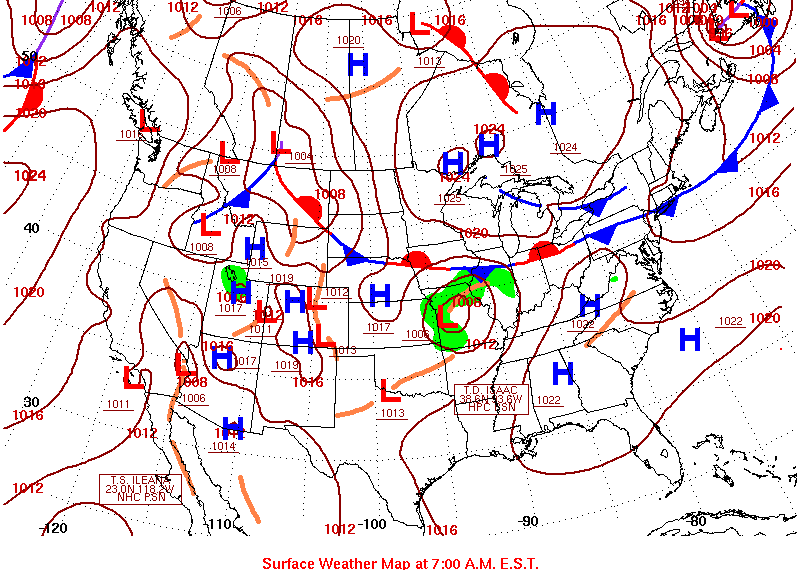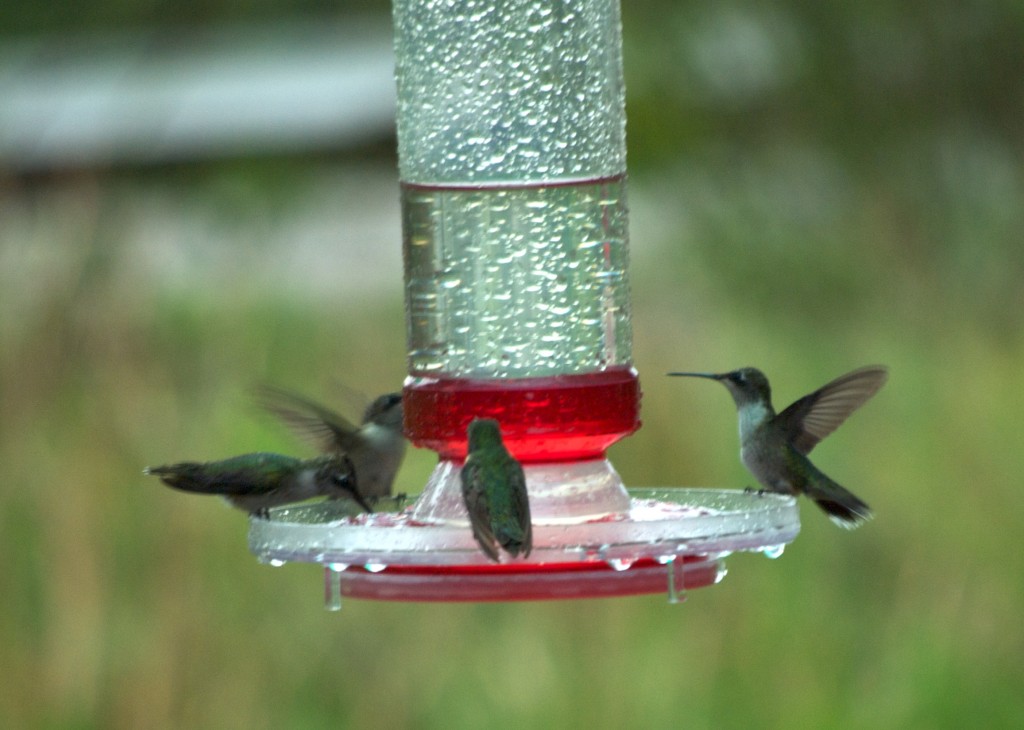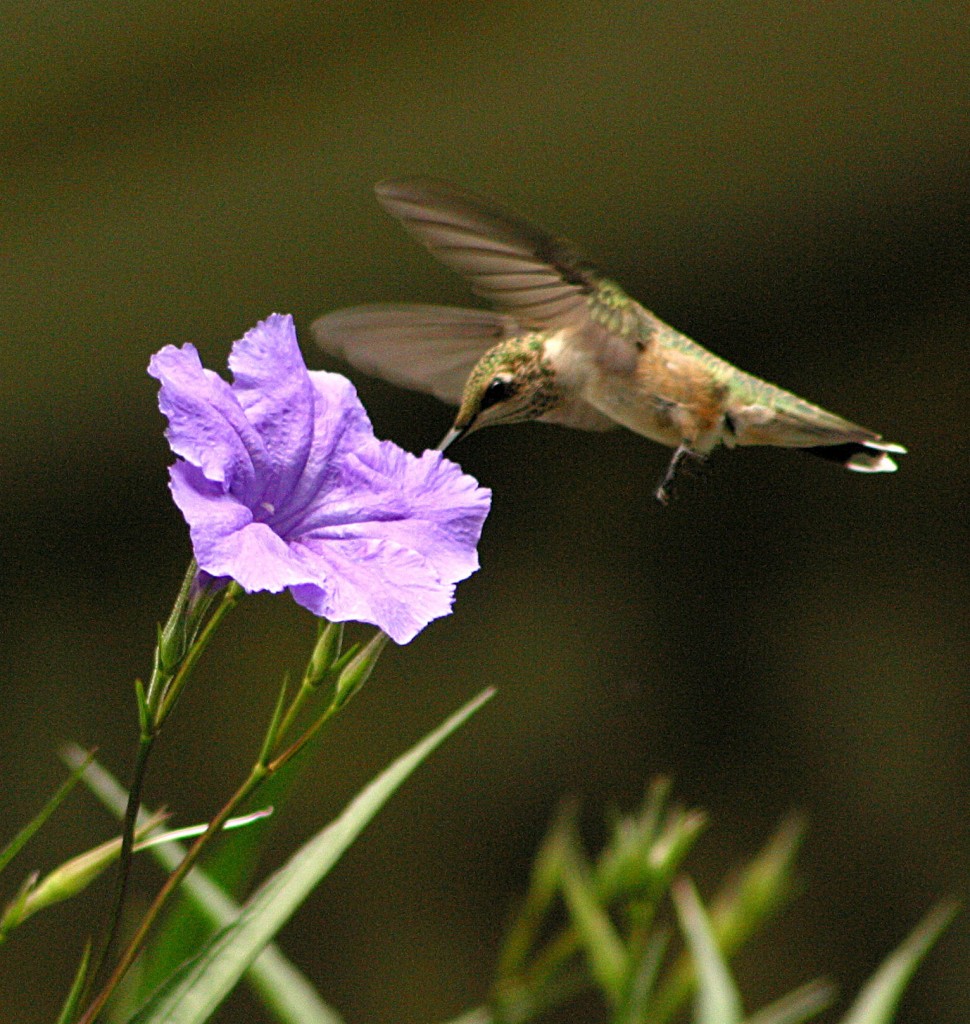Hurricanes and Hummers

Weather chart from 1 September 2012, showing the still-rotating Hurricane Isaac. Image courtesy U.S. National Weather Service.
The recent passage of the remnants of Hurricane Isaac brings up two very interesting questions. First, has there ever been a hurricane in Monroe County or anywhere in Illinois. Technically a hurricane is a tropical cyclone capable of generating sustained surface winds of 74 MPH or greater. It’s weaker variant, a tropical storm has sustained winds of 39-74 MPH; and a still weaker cousin, a tropical depression, produces winds less than 39 MPH.
As is often the case, hurricanes and tropical storms make landfall somewhere on the coastal U.S., are cut off from an endless supply of oceanic moisture, are slowed down by the forces of terrestrial friction, and quickly weaken to a tropical depression and then become an extra tropical cyclone, a plain old low pressure system—a big red “L”- like you see on the TV weather maps.
So the answer is no—Illinois has never experienced a hurricane. But our state and county have experienced 20 tropical depressions or extra tropical cyclones – all remnants of stronger systems—since 1900, when national record keeping began. And the frequency of these systems is very interesting story.
Monroe County saw rainfall from tropical systems in June 1902, September 1906, September 1941, and October 1949. (The practice of naming hurricanes began in 1952.) The remnant of Hurricane Audrey, in June 1957, was the biggest rainout producer to date, with most of Illinois receiving 10 inches of precipitation.
A Texas tropical storm in 1960, and remnants of Hurricanes Carla in 1961, Debra in 1978, Claudette in 1979, Tico in 1983, Paine in 1986, Chantal in 1989, and Lester in 1992 followed. Tico, Paine and Lester are noteworthy because they originated in the Pacific and moved completely across the country. Lester became infamous, crossing the U.S. to join forces with the nefarious Andrew, the third deadliest and costliest hurricane in our country’s history.
In 2005, Monroe County experienced a quadruple-yet-welcomed whammy, with the remnants of Arlene in June, Dennis in July, Katrina in August, and Rita in September providing a cumulative 8” to 10” of rain to our drought-stricken area.
In 2008 we saw a double-hitter, with Gustav and Ike bringing 5-8” of precipitation to the county in September. And Isaac’s recent Labor Day weekend visit added 1-3” of rain to the history books.
This brings us to the second important question. What happens to our county’s beloved mascots, our ruby-throated hummingbirds, who are departing on their southward fall migrations from mid-August to mid-September, in the face of a hurricane?
It’s estimated that 7 million ruby-throated hummingbirds make their twice- annual migration from wintering grounds in southern Mexico and Central America to breeding grounds in the eastern U.S. and southernmost eastern Canada. The quesstimate for summering and breeding hummingbirds in Illinois is a couple-three hundred thousand. And all use the Mississippi River flyway during their migrations.
Hummingbirds and hurricanes have been dealing with each other for tens of thousands of years. And ruby-throated humming birds, those gem-like, bedazzling beauties, have brains. All birds can sense changes in barometric pressure and know of an approaching low-pressure system. Hummingbirds also have tremendous gripping power with their tiny toes, and their small frames present a very small surface area to extreme wind conditions.
Simply put, hummers are masters at hunkering down and holding up under extreme weather conditions. Their challenge is around the question of timing. A hummingbird beats its wings on average 52 times a second in flight. So long-distance travel takes up a tremendous amount of energy. In preparation for migration, our hummingbirds will double their body weight as a reserve for their migrational flights.
Hummingbirds migrate largely at night and proceed as individuals, alone in their long journey. Typically they leapfrog, fly and stop to replenish their energies and body fat. Most of our hummers, when they arrive at the Gulf Coast, eat and recuperate, and then make their 500 mile, 18-22 hour, non-stop over-water flight to wintering grounds. They loose half their body weight in the process. So facing a hurricane is a life- threatening event, and if caught over the Gulf, mortality is certain.
The aftermath of Hurricane Katrina’s landfall provides an illustrative example. When rescue workers and scientists entered New Orleans immediately after Katrina’s weakening and move up the Mississippi, they estimated that 70% of all the bird life in the city and parishes had been killed. And, most possible bird food sources — flowers, berries and bugs–were destroyed.

Juvenile ruby-throated hummingbirds flock to feeders during the rains brought by Hurricane Isaac. Pen DauBach, Clifftop.
Immediately after the storm’s clearing, thousands of hummingbirds, which had hunkered down up river, began showing up all over town, looking for food reserves. The call went out and “Operation Backyard Recovery” began, with Audubon and birding groups from all over the country rushing hummingbird feeders and food supplies to the area. Hurricane Katrina took its toll however. Hummingbird numbers breeding in the U.S. dramatically declined over the following two summering seasons, 2006 and 2007.
A large part of the hummingbird mortality was, no doubt, juveniles, birds born during that year’s breeding season. Juvenile hummers are just like our juvenile kids; they have a devil-may-care attitude and think they’re going to live forever. It is estimated that only one-third of each season’s new crop of hummingbirds will survive their first year.
That’s why, if you provide hummingbird feeders, you should keep feeders and food out during fall migration until you have not seen a hummer for two weeks. Juvenile hummers are famous for late fall migration, with some recorded in Monroe County in late October and early November. The standard solution for hummingbird feeders is one cup of white sugar to four cups of water. Never use honey, red dye or artificial sweeteners — these may be fatal to the birds. During hot weather change the feeders every 2-3 days to prevent spoilage.
So keep your feeder stocked, as we await another hurricane landfall, on the embattled southwest coast of Illinois.
CLIFFTOP, a local nonprofit organization, is focused on preserving and protecting area bluff lands.
A version of this article appeared in the 21 September 2012 edition of the Monroe County Independent.
© 2012 all content rights reserved Clifftop NFP
Comments are currently closed.

